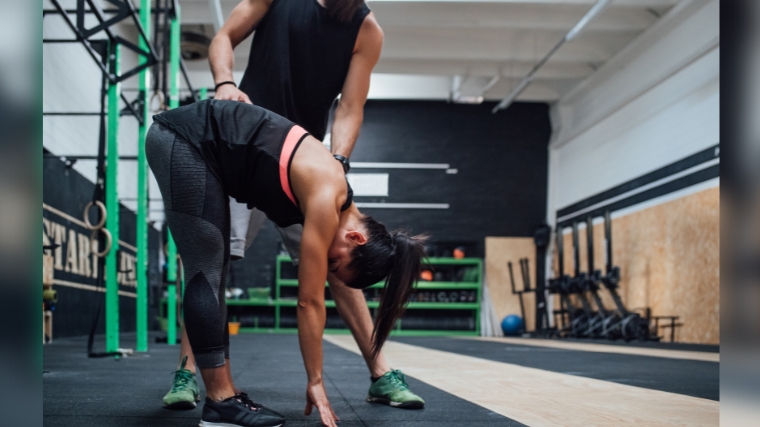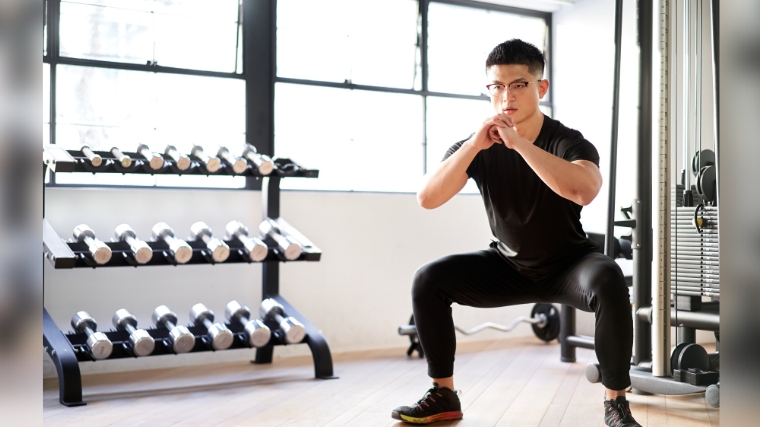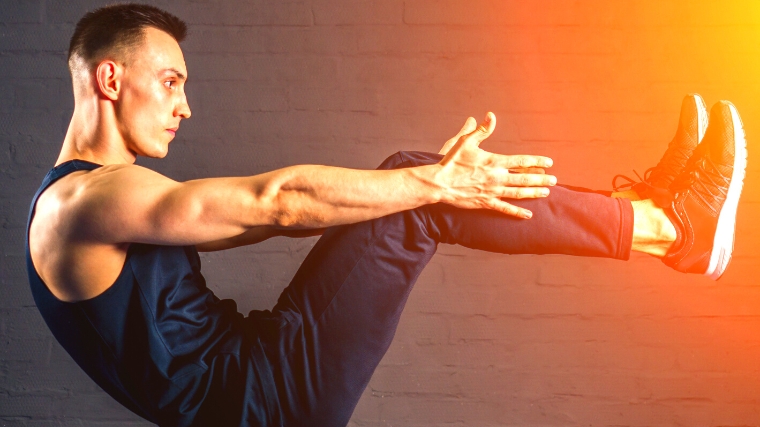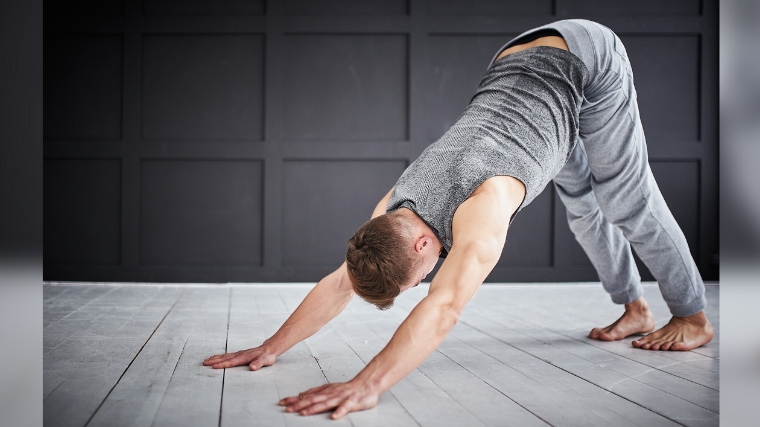When you’re a CrossFitter, your workouts are all about improving the quality of your movements. Everything from the nutrition to the recovery habits of CrossFit athletes is dedicated to maximizing the efficiency of movements so that they can get better at their workouts of the day (WODs).

One of the most crucial aspects of improving your CrossFit performance is also perhaps the most overlooked. But don’t dismiss the power of stretches for CrossFitters in improving your performance. By utilizing the best CrossFit stretches before your workouts, you can get better at your WODs both in the short-term and the long term.
Best CrossFit Stretches
- Cat Cow
- Downward Facing Dog to Cobra
- Forearm Stretch
- Inch Worm
- Overhead Duck Walk
- Dynamic Long Lunge
- Frog Stretch
- Armless Prayer
- Bottom Squat Rotation
Editor’s Note: The content on BarBend is meant to be informative in nature, but it should not be taken as medical advice. When starting a new training regimen and/or diet, it is always a good idea to consult with a trusted medical professional. We are not a medical resource. The opinions and articles on this site are not intended for use as diagnosis, prevention, and/or treatment of health problems. They are not substitutes for consulting a qualified medical professional.
Cat Cow
This dynamic movement, borrowed from yoga, will encourage you to focus on your breathing. The ability to regulate your breathing is a tremendously important aspect of CrossFit. You’ll need to keep breathing through extremely taxing and overwhelming WODs that will have you gasping for breath.
The more practice you have with syncing your breathing to your movements, the better. You’ll also start to activate your back muscles and the front of your core. The deeper you breathe into this movement, the more effective it will be at also involving your shoulder blades and lumbar spine.
Benefits of the Cat Cow
- Performing cat cows will help you learn to coordinate your breath with your movements, which comes in handy during intense WODs and lifts.
- Connecting your breath and your core is especially helpful when bracing to perform heavy lifts.
- The cat cow helps you slow down and focus, which can help you ease into your warm-up mentally.
How to Do the Cat Cow
Get on your hands and knees. Place your knees directly underneath your hips and your hands under your shoulders. Inhale and draw your belly down toward the ground. Tilt your tailbone up to the sky. Exhale and arch your back. Pull your shoulder blades away from each other and tuck your tailbone down.
Downward Facing Dog to Cobra
Your core is part of every movement you do. Without a strong, activated core, you’ll have a ton of trouble getting through your WOD. Performing a down dog and transitioning into cobra will not only help strengthen your core — it’ll also activate your muscles to prepare you for more intense movement.
This two-in-one exercise — part of a yoga flow — will help you get ready for intense activity. It won’t only focus on your core and spine, though. You’ll also be warming up your wrists, forearms, and shoulders.
Benefits of the Downward Facing Dog to Cobra
- Holding a downward facing dog will help you strengthen and mobilize your wrists, shoulders, and forearms. This is essential for preparing for everything from thrusters and front squats — which require a strong front rack position — to handstand walks and handstand push-ups.
- Transitioning from one movement to another improves upper body flexibility and helps prepare you for more intense movements.
- This flow strengthens your core and activates the muscles you’ll need to hold a strong core brace.
How to Do the Downward Facing Dog to Cobra
Start in a downward-facing dog position, with your fingers spread wide, your forearms rotated forward, and your hips tilted up and back toward the ceiling behind you. Pedal your feet. Keep your heels pressed down as much as you can.
On an inhale, pull your hips down toward the ground and shift your upper body forward so that your hands are underneath your shoulders. Allow the front of your core to feel a stretch. Reverse the movement on an exhale.
Forearm Stretch
Your forearms need to be ready to perform powerful CrossFit workouts. Everything from rope climbs to front-rack walking lunges require strong forearms with high levels of muscle activation.
Stretching your forearms doesn’t only get your arms ready for WODs, though. You’ll also be helping to mobilize your wrists, which you need to get through everything from thrusters to handstand walks.
Benefits of the Forearm Stretch
- Stretching your forearms gets your arms ready for action.
- Activated forearms are more likely to be prepared to take on the rigors of everything from loaded carries to high-rep pull-ups.
- This move will also mobilize your wrists, which will pay off in spades during handstand push-ups and walks.
How to Do the Forearm Stretch
Start on all fours, but shift your knees slightly wider than your hips. Rotate your hands so that your fingertips are facing your body. Lean back slightly to feel a stretch in your wrists and your inner forearms. Pulse back and forth slowly.
Inch Worm
When you perform the inch worm, you’ll be waking up your back, shoulders, and hamstrings. Make sure you’re keeping your legs as straight as you can during this dynamic movement.
The inch worm won’t only prepare your back and hamstrings for action. You’ll also be getting your wrists ready to support the intense demands of your WOD.
Benefits of the Inch Worm
- You’ll stretch your hamstrings and mobilize your upper back and shoulders.
- This move will help get you to breathe a little harder and raises your body temperature, which helps prepare you for more intense movement.
- You’ll activate your wrists and forearms while improving your full-body coordination.
How to Perform the Inch Worm
Start by standing with your feet roughly hip-width apart. With a slight bend in your knees, bend down until your hands reach the ground. While maintaining a stretch in your hamstrings, walk forward on your hands until you’re in a push-up position.
You can add a push-up here if you want to get a little chest activation in. Reverse the movement by walking your hands up and standing again.
Overhead Duck Walk
CrossFit is full of shoulder-to-overhead movements. Because of this, it stands to reason that you’ll need a significant overhead stretching component in your warm-up.
This particular move also challenges your thoracic, hip, and ankle mobility. You’ll also have to be tremendously well-coordinated, which is required by many CrossFit movements.
Benefits of the Overhead Duck Walk
- This move directly prepares your body to perform overhead movements, particularly snatches and overhead squats.
- The walking component of this stretch really gets into your hips and promotes intense lower body mobility.
- Your ankle and thoracic mobility will also be tremendously improved by this movement.
How to Do the Overhead Duck Walk
Sink into a deep bodyweight squat. Reach your hands up and over your head in a snatch position, keeping your torso as upright as possible. If you wish, you can hold a resistance band, PVC pipe, or even an empty barbell.
Staying in your deep squat position and maintaining your overhead position, shuffle forward in a duck walk. If you’re able, you can shift backward, as well.
Dynamic Long Lunge
As a CrossFitter, you run across your fair share of lunges. Walking lunges are often a key component of WODs, performed in a wide variety of ways. Front-rack walking lunges and overhead walking lunges, for example, are often central features of daily workouts.
The dynamic long lunge won’t have your feet moving, but your legs certainly will be. You’ll wake up your hips, quads, ankles, and hamstrings all at once.
Benefits of the Dynamic Long Lunge
- This move opens up your hips, promoting the kind of hip mobility you’ll need during many different WODs.
- You’ll also alternately lengthen your hamstrings and quads during this movement.
- Especially if you’re able to lean forward far enough, this move will help stretch your calves and improve your ankle mobility.
How to Do the Dynamic Long Lunge
Sink down into a lunge. Place your back foot laces down on the ground and shuffle your back knee as far back as you feel able. Keep your hips squared. With your front heel planted but your toes rising up off the ground, shift your weight backward to stretch your front hamstring.
Place your toes back on the ground. Keep your front heel planted and lean as far forward as you can, tracking your front knee far over your toes. If you need to, scoot your leg outside your hip slightly to accommodate your stomach and torso.
Frog Stretch
The frog stretch is a classic dynamic movement that will help make sure you’re improving your flexibility all across your lower body. By shifting back and forth, you’ll be simulating a deep squat — but without all that pressure on your spine from a loaded barbell.
[Read More: The Best Upper Body Exercises and Workouts]
Since you’ll be keeping your shins parallel to each other and your feet pointing out, you’ll also be targeting your ankle mobility. This stretch will also challenge your full-body coordination, with your upper body working with your lower body to get the deepest stretch possible.
Benefits of the Frog Stretch
- Performing this movement properly simulates a deep squat but doesn’t put any external load on your body.
- The frog stretch targets your hip mobility, ensuring that you’re warming up your hips and increasing your mobility as much as possible.
- Due to the position of your feet, this move will also help improve your ankle mobility.
How to Do the Frog Stretch
Set up with your knees underneath your hips. Shift so you can spread your knees as far apart as you can. Point your toes out to the sides, pulling them up toward you. Keep your heels in line with your knees so that the bottoms of your legs are parallel to each other.
Lean forward onto your forearms. Sink your glutes back toward your ankles. Shift your hips all the way forward. Then go back again.
Armless Prayer
This static stretch targets nearly every part of your upper body for increased flexibility. You’ll learn to become comfortable with an intense overhead stretch. That will come in handy for high-rep sessions involving overhead presses and pulls.
The armless prayer will involve your lats, delts, traps, and triceps. You’ll also get a nice stretch through your hips and even your ankles.
Benefits of the Armless Prayer
- Especially when combined with more active movements, this stretch can help improve your overhead mobility.
- Particularly if you hold a PVC pipe in your hands during the stretch, you’ll be contributing to a stronger front rack position.
- This move targets your lats, traps, delts, and even your triceps for increased mobility.
How to Do the Armless Prayer
Get into a child’s pose with your legs knees spread wide and your hips pushed back toward your ankles. Reach your hands far forward and slightly outward. Bend your arms and bring your palms down to touch your upper back. Keep your elbows as far up as possible. Breathe slowly and deeply through your belly. Hold for 30 to 60 seconds.
Bottom Squat Rotation
Sitting in the bottom of a deep squat is something you’ll have to be very comfortable with as a CrossFitter. During heavy snatches, for example, you’ll need to be comfortable stabilizing the barbell overhead and pressing up through your entire body. If you don’t have confidence in the bottom of your squat, that’s a lot less likely to happen.
Adding an upper body rotation here also helps enhance your thoracic mobility. This is crucial for everything from overhead barbell lifts to handstand walks and pull-ups.
Benefits of the Bottom Squat Rotation
- You’ll improve your thoracic mobility unilaterally — one side at a time — which will help you combat mobility imbalances.
- This movement will help you develop comfort and confidence at the bottom of your squat, which is essential during heavy or high-rep overhead squats and snatches.
- Your hip mobility is bound to improve here, as you’ll be spending the entire time in a deep squat position.
How to Do the Bottom Squat Rotation
Sink into a deep bodyweight squat. Keep your torso upright. Place your arms between your knees. Twist your torso as you raise one arm up and around toward the ceiling, such that you are looking upward as you gaze at your raised arm. Come back to center and repeat on the other side.
Benefits of Stretching for CrossFit
If you want to get better at the sweat-inducing, glamorous lifts and feats of flexibility and strength that characterize CrossFit WODs, you’d best make sure you warm up properly. Your workouts will be much more effective if you integrate stretching into your routine. Here’s how.
Potential Injury Prevention
Since CrossFit is a very high-intensity sport, doing what you can to prevent injury is key.

[Read More: Our Favorite Forearm Workouts, + the Best Forearm Exercises]
When you combine static stretching into a full warm-up routine (complete with dynamic stretching and muscle activation), it can help increase injury prevention — particularly during high-intensity activities like sprinting and rapid directional changes. (1)
Better Form
When taking exercises to a full range of motion, strength training alone can help improve lifters’ flexibility. (2) But if you’re looking for optimal improvements, adding stretches to your strength regimen may be the most effective. (2)

Increasing your range of motion is hugely important when you’re looking to improve your form for a wide variety of exercises. The deeper you can sink into a squat, for example, the more likely you are to be able to stand up with a very heavy barbell with safe, efficient form.
Less Missed Reps
The more easily you can sink into deep ranges of motion, the less likely you are to get called out for a no rep. Moves like walking lunges in CrossFit competitions don’t just require you to have the requisite strength to perform them. You also need enough hip mobility to touch your back knee to the ground — otherwise, you risk a no rep.
The better your mobility, the better your range of motion during lifts. This will likely translate into less missed reps, which is only going to improve your performance.
How to Program CrossFit Stretches
Stretches are a critical part of every good CrossFit warm-up. To figure out how stretches fit into the best warm-ups possible, check out the following articles:
- The Best CrossFit Warm-Up To Help You Crush Your Next WOD
- How To Properly Warm Up For Weightlifting Workouts
- The Best Way To Warm Up Before Lifting Weights
Read on to learn how to program your stretches specifically.
Select Your Stretches
Before your workout of the day, think about which parts of your body you’ll need to work on most closely. If you’re going to be working overhead, you’ll want to target your wrists, forearms, and thoracic mobility during your stretches.
Most CrossFit workouts — whether you’re predominantly targeting your upper body or lower body — will also require a great deal of hip and ankle mobility. So you’ll likely want to toss in hip and ankle-focused moves during your warm-ups, too.
To select the right stretches, you’ll also want to consider your specific weaknesses. If you have a difficult time holding a snatch grip overhead, emphasize thoracic mobility during every warm-up. The same principle applies to ankle mobility or any other mobility limitation you’re working with.
[RELATED: Best Mobility Exercises]
Choose Your Timing
All things being equal, you’ll always want to stretch as part of a complete warm-up before a CrossFit workout. But that’s not to say that your warm-up (discussed in more detail below) is the only time you can do these stretches.

If possible, perform some or all of these stretches every day — even when you’re not working out. Putting together a five to 20-minute stretch routine daily, or every other day, may be able to help increase your range of motion overall. This can carry over into your routine and really help you take your CrossFit game to the next level.
Programming Static Stretching
While the overall impact of static stretching can help improve your range of motion — which bodes well for maintaining good form during intensive CrossFit movements — you might not want to static stretch before your workout. Some research suggests that holding stretches for 25 seconds at a time immediately before strength training can reduce the day’s training volume and hypertrophy potential. (3)
However, it’s important to note that most studies regarding the potential impacts of static stretches do not include dynamic movements after static stretches. (2) If you do opt to include static stretches as part of your warm-up, research suggests that you will boost your injury-prevention potential and range of motion if you do dynamic stretches after static stretching. (1)(2)
When you program your static stretching, plan to hold your stretches for 30 or 60 seconds each instead of a higher range like 120 seconds. (4) Research suggests that while holding stretches for two full minutes will increase your range of motion, you might also be able to generate less muscular force during your workout. (4) More moderate stretching (30 to 60 seconds) may give you benefits without the detrimental effects of longer stretches. (4)

If you’re just doing your stretches on active recovery days, off days, or after your workout, feel free to hold stretches for longer, as you won’t have to worry about performance immediately afterward.
Programming Dynamic Stretching
In contrast to static stretching by itself, dynamic stretching in your warm-up may promote more muscular force and power during your workout. (5) Dynamic stretching — which includes most of the movements on this list — also can offset the potentially negative effects of static stretching on your workout. (1)(2)
Moderately-timed static stretches are important for increasing your range of motion, but you’ll want to program dynamic stretches after your static stretches. (4)(1)(2) This will help ensure that your warm-up is maximally effective at injury-prevention, as well as increasing your range of motion and thus improving your form.
Stretch Out Your Gains
The name of the game in CrossFit is improving your movement quality. When you move better, you move more efficiently. And when you’re more efficient, you can improve your WOD times and one-rep maxes alike. Stretching in CrossFit is one key in your arsenal to a better performance — so stretch your muscles to stretch the extent of your gains.
References
- Chaabene H, Behm DG, Negra Y, Granacher U. Acute Effects of Static Stretching on Muscle Strength and Power: An Attempt to Clarify Previous Caveats. Front Physiol. 2019 Nov 29;10:1468.
- Simão R, Lemos A, Salles B, Leite T, Oliveira É, Rhea M, Reis VM. The influence of strength, flexibility, and simultaneous training on flexibility and strength gains. J Strength Cond Res. 2011 May;25(5):1333-8.
- Junior RM, Berton R, de Souza TM, Chacon-Mikahil MP, Cavaglieri CR. Effect of the flexibility training performed immediately before resistance training on muscle hypertrophy, maximum strength and flexibility. Eur J Appl Physiol. 2017 Apr;117(4):767-774.
- Reid JC, Greene R, Young JD, Hodgson DD, Blazevich AJ, Behm DG. The effects of different durations of static stretching within a comprehensive warm-up on voluntary and evoked contractile properties. Eur J Appl Physiol. 2018 Jul;118(7):1427-1445.
Featured Image: Eugenio Marongiu / Shutterstock